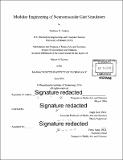Modular engineering of neuromuscular gait simulators
Author(s)
Furtney, Matthew D
DownloadFull printable version (7.582Mb)
Other Contributors
Program in Media Arts and Sciences (Massachusetts Institute of Technology)
Advisor
Hugh Herr.
Terms of use
Metadata
Show full item recordAbstract
In this thesis we present a novel approach to the computer simulation of forward dynamic gait models and the optimization of parameters that must be tuned for such models. This methodology is not limited to gait simulation, and could be useful for any situation in which a complex Simulink model requires variables to be tuned via machine learning to optimize all heuristic that can only be evaluated via simulation. Through the lens of Biomechatronic engineering research, we combine the fundamentals of software engineering with a refinement of the best practices of Matlab and Simulink programming and a working knowledge of inherent Matlab and Simulink constraints to construct a framework for rapid model development. Key features of this methodology include: the use of Simulink as an environment for rapidly prototyped models, the use of and construction of custom Simulink libraries, and use of the Matlab Optimization Toolbox. This methodology uses parallel evaluation of rapid acceleration Simulink executables to minimize optimization time, and allow research teams to take advantage of parallel processing and cloud computing. This methodology was applied to a bouncing gait model developed by Hartmut Geyer for evaluation. We demonstrate its effectiveness by simulating this model using a custom library of model components, such as ground contact model, Stateflow control, heuristic computation, and body segments.
Description
Thesis: S.M., Massachusetts Institute of Technology, School of Architecture and Planning, Program in Media Arts and Sciences, 2016. Cataloged from PDF version of thesis. Includes bibliographical references (pages 72-73).
Date issued
2016Department
Program in Media Arts and Sciences (Massachusetts Institute of Technology)Publisher
Massachusetts Institute of Technology
Keywords
Program in Media Arts and Sciences ()